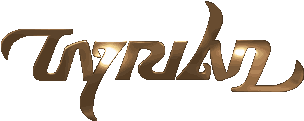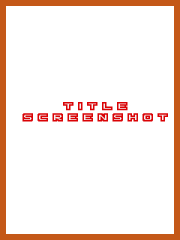Tyrian
Title screen
| Developer: | Eclipse Software |
|---|---|
| Music: | Alexander Brandon, Andras Molnar |
| Program: | Jason Emery |
| Art: | Daniel Cook |
| Release date: | 1995-06-10 |
| Next game: | Next game in a series |
Contents
Tyrian
Tyrian is a vertical scrolling shooter computer game developed by Eclipse Software and published in 1995 by Epic MegaGames. Tyrian was programmed by Jason Emery, illustrated by Daniel Cook, and its music composed by Alexander Brandon and Andras Molnar. The game was re-released as freeware in 2004. A free and open-source port of the game started in April 2007.
Gameplay Overview
The gameplay overview section starts out with the controls of the game, including all of the buttons used and what they're used for. It's recommended to keep the control layout simple and easy to understand. Feel free to note the directions that the player can move as well, if you wish or if it's notable (horizontal only, 4 way, 8 way, analog, etc). Advanced and strategic ways of manipulating the controls can be included in a following Strategy section, or wherever that information might be the most relevant.
Controls
- A: Description
- A (Press): Description
- A (Hold): Description
- B: Description
Unlockable Secrets
If a game features unlockable modes, extras, secrets character etc. such as the Mahou characters in Battle Garegga or Strong Style in DoDonPachi DaiFukkatsu that are relevant to the basic system of a game, put these codes here. Otherwise, omit this section.
Characters / Ships / Styles
This section should include the characters or ships, if any, that the player can select in the game. Ideally, different "styles" (for games that use them, such as DoDonPachi) would also be included here.
If there is only one playable character and no elements to augment/customize your ship, this section can be omitted from the page.
Weapons
This section describes the weapons that you use in the game and elaborates on them further. Stuff like standard shots, focus shots, bombs, weapon pickups that differ in functionality, options, etc. This can be omitted if not relevant to the game in question.
Items
This section describes any and all collectibles that you acquire in the game. An example being any Power Up items or Medals from Battle Garegga. Include secret items such as extra lives as well.
Rank
If the game features a relevant rank system, use this section to discuss it in more detail. Otherwise, this can be omitted.
Loops
If a game features a loop system, elaborate on it in detail here. Otherwise, omit this section.
Scoring
This section should cover a general breakdown of the scoring system of the game. Feel free to put the meat and potatoes here. A great example of a scoring section is the DoDonPachi page.
Strategy
See (Template Page)/Strategy for stage maps, enemy and boss descriptions, walkthroughs, and advanced play strategies.
This section details some particular strategic information about the game and its gameplay, such as hidden 1UPs and some basic scoring tricks. For anything particularly deep or highly complex, you can probably leave it in the Strategy page.
(Currently evaluating whether or not this specific section should even include information outside of the separated Strategy pages. Worth thinking about as a community.)
Story
The game is set in the year 20,031. The player takes on the role of Trent Hawkins, a skilled spaceship pilot. While on the planet Tyrian, a hostile drone shoots his best friend, Buce Quesillac. Before dying Buce warns Trent that the drone belonged to the militaristic MicroSol megacorporation. MicroSol has discovered Gravitium (the game's brand of Unobtainium) on Tyrian and seeks to keep it a secret. Now on MicroSol's hit list, Trent manages to secure a small, armed spacecraft and set out the free world of Savara.
Development History
Development
Tyrian was developed by a credited total of 11 people, with "three main drivers" — Alexander Brandon (composer and writer), Jason Emery (programmer and level designer), and Daniel Cook (artist and interface designer). For the aforementioned developers, Tyrian was their first commercial video game.[1][2]
The origins of Tyrian began as an experiment in 1991, with a young Jason Emery showing his friend Alexander Brandon the preliminary workings of a scrolling background. The two continued developing, and eventually decided the work could be shown to a game company. Brandon wrote a proposal document and sent it to the two leading shareware game publishers of the time, Epic MegaGames and Apogee. However, the game lacked any sound or music, and the graphics were "definitely not professional". As such, "neither got overly excited", but both showed interest.
The two developers thought they would never find a publisher. However, after a long wait, Robert Allen – head of Safari Software – considered Tyrian to fit perfectly with their company, which handled smaller scale projects. Robert Allen had word from Cliff Bleszinski that Tyrian was very similar to Zanac, thinking that it should be followed up.
Robert Allen gave leads to sound coders and artists, the first being Bruce Hsu who created interface graphics and character faces. Artist Daniel Cook was hired after composer Alexander Brandon showed interest in his artwork, which was—unbeknown to Cook—"sent around" by a friend. After he was sent a short list of levels, Cook created sample artwork on an Amiga 1200. It was met with praise by the other developers, who asked him to "make some more!". The artwork was completed in a 4-month period.[1][3]
After work began on graphics, the popularity of Tyrian rose at Epic MegaGames. Arturo Sinclair from Storm Front Studios joined to create rendered artwork for planets and character faces. The developers wanted a "simple and fun" interface, and changed it at least three times before deciding on a final design. At this point, Tyrian was almost complete; with the "Loudness" sound system, near-completed sound effects, and a marketing plan head by Mark Rein. At this time, Tim Sweeney approached the team and informed them Tyrian was to be published as a full-fledged Epic MegaGames product. It was later released in 1995.
The data cubes found in the game's Full Mode contain various references to its parent publishers, including One Must Fall 2097, Jazz Jackrabbit, and Pretzel Pete (Tyrian 2000). The Pretzel Pete Truck and its weapon is a reference to the Pretzel Pete video game.
Version Differences
Versions and re-releases
Tyrian
Version 1.0 of the game was originally released as shareware, consisting of episode 1 of the game. Version 1.1 was the first published registered version, consists of the first three episodes, and includes various bugfixes. The registered version also includes the ship editor, which was later available as separate download. Version 2.0 added Episode 4 (An End to Fate) and several new game modes, like the two-player mode. Version 2.01/2.1 fixed some keyboard bugs and includes the "Christmas mode", triggered by starting the game in December.
Tyrian 2000 (3.0)
In 1999, Tyrian was re-released as Tyrian 2000, which includes an additional fifth episode and bug fixes.
Additional ships include Phoenix II, Storm, Red Dragon, Pretzel Pete Truck (from the Pretzel Pete video game published by XSIV Games). The datacube "TRANSMISSION SOURCE: Epic MegaGames" game and was renamed "TRANSMISSION SOURCE: XSIV Games" with a Pretzel Pete game ad (however, other references to Epic MegaGames titles remain).
Although it claims Windows compatibility, this is achieved using a .PIF file, not by building a native Windows application.
Game Boy releases
World Tree Games developed versions for the Game Boy Color and Game Boy Advance. After the publisher Symmetry Entertainment closed down, the European publisher Stealth Productions, Inc. (Stealth Media Group, Inc.) obtained the publication rights, but the game was cancelled.
Both Game Boy versions were eventually released in compiled format in 2007 as freeware by World Tree Games.[4]
In the Game Boy Color version, the Full Game incorporates a shorter story (from Episodes 1-4) than the original DOS game, but planet Ixmucane core always gets destroyed at the end, and the levels were redesigned. The rear weapon from the DOS game is not available. The player can carry two Sidekick weapons at once, but only one is usable at a time. New game modes and items can be unlocked by purchasing Extras using credits obtained by completing a stage.
The Game Boy Advance version incorporates graphics from the DOS game, but the level layout and game play are based on the Game Boy Color game. Two Sidekick weapons can be fired at the same time. Super Arcade and audio are not included. New to this game is Challenge mode, where additional levels are unlocked by completing existing Challenge levels.
OpenTyrian
In February 2007 the Pascal (and x86 assembly) source code for Tyrian was delegated to a small group of developers to re-write it in C, in a project named OpenTyrian, licensed under the GNU General Public License]. Jason Emery released Tyrian in 2007, along with some Game Boy and Game Boy Advance versions.[4] Following that announcement, in April 2007 Daniel Cook announced the free availability of his Tyrian artwork (not including the later work for the Game Boy Color edition and for Tyrian 2000) under generic liberal terms of the open content Creative Commons Attribution 3.0 License.[5][6] OpenTyrian was originally stored on the BitBucket repository before moving on to GitHub.[7]
Trivia
- Cool facts and random tidbits go here!
Gallery
See (Template Page)/Gallery for our collection of images and scans for the game.
Other
We have support for wikitables, giving us the potential to add lots of cool info in a small box on the page somewhere, but we are not using them at the moment. I'm just leaving this here so we can have it handy in case we decide to actually use them. Feel free to not use this section.
| (Template Page) |
|---|
| put your stuff here |
References & Contributors
- ↑ 1.0 1.1 Lost Garden: Free game graphics: Tyrian ships and tiles
- ↑ Club Silicon: Tyrian Jukebox
- ↑ Lost Garden: The joyful life of the lapsed game developer
- ↑ 4.0 4.1 worldtreegames (2007, archived)
- ↑ Free game graphics: Tyrian ships and tiles on lostgarden.com by Daniel Cook (2007-04-04)
- ↑ Lost garden license on lostgarden.com "All licensed items use the Creative Commons Attribution 3.0 License" (2007)
- ↑ OpenTyrian on bitbucket.org "OpenTyrian 2.1.20130907 has been released. [...] There are also console builds for Android, Amiga, Atari Falcon 060, BlackBerry, Dingoo, Dreamcast, DS, GameCube, Gizmondo, GP2X, GP32, GCW Zero, Mac OS X, Nokia Internet Tablets, PSP, PS3 Linux, Symbian, Wii, Wiz, and ZuneHD."

